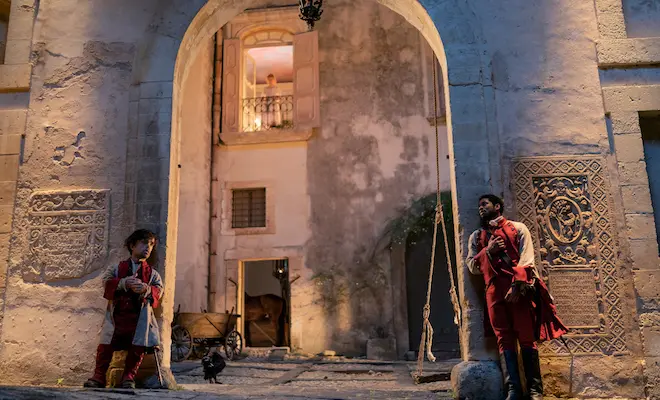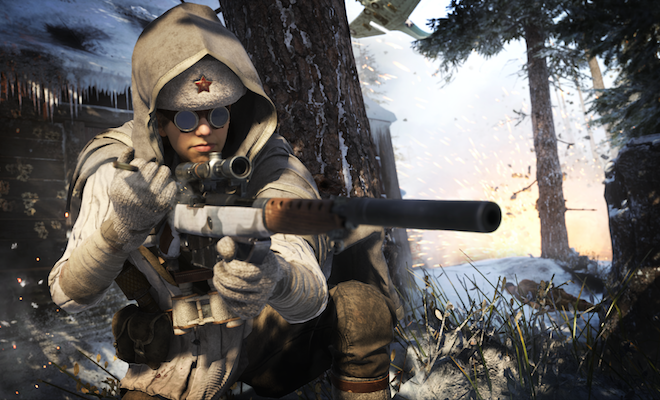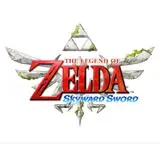 It was 24 years ago this Christmas that I unwrapped a present that would forever change my life. The wrapping paper peeled back to reveal a peculiar gold box, and I tore into it to find an equally unique gold-plated game cartridge. The game was called, The Legend of Zelda.
It was 24 years ago this Christmas that I unwrapped a present that would forever change my life. The wrapping paper peeled back to reveal a peculiar gold box, and I tore into it to find an equally unique gold-plated game cartridge. The game was called, The Legend of Zelda.
All my other gifts were forgotten (including Konami’s Rush ‘N Attack, which I had opened right before this one). I ran to my room and booted up my NES and the title screen popped onto my TV. I quickly pressed start and input the ridiculous name, “Jon 1.” My adventure began that day as I stepped into a cave and was given a simple wooden sword, because, “it was dangerous to go alone.”
What followed was arguably the greatest gaming experience of my life to that point and for many years after. It wasn’t until November of 1998 when the Zelda series abandoned the top-down format for three dimensions, and the Ocarina of Time became the gold standard for Zelda games.
That is until now.
The Legend of Zelda: Skyward Sword is the latest game in the long-time Nintendo series that has had over 15 game titles spread over ten different systems. It is also the first built exclusively for the Wii system (2006’s Twilight Princess was a GameCube game that was converted into a Wii launch title). It is also the first Zelda game to take full advantage of the Wii Motion Plus controller.
The world of Skyward Sword is different as it doesn’t take place in Hyrule. Well, at least a Hyrule that you recognize. As the story goes (told in an amazing watercolor cinematic opening) the world was over run by darkness and monsters, ruled by the Demon Lord, Demise. To protect her people, the Goddess Hylia, raised a chunk of land high into the sky and populated it with humans.

She then went below the clouds and into battle with Demise, and was finally able to seal him away, but in so doing, she also sealed off the entire world below. And humanity was left to exist only on the floating land mass known as Skyloft.
Centuries later, the citizens of Skyloft now live and work in relative peace. There is a temple to worship the goddess and an academy that trains the knights who patrol the skies above, as well as a bazaar and assorted farms.
The game begins as a young boy named Link (or whatever name you input…and for the record, I no longer use “Jon 1”) wakes in his bed, ready to take the final trial to become a Knight of Skyloft. Link’s best friend is the schoolmaster’s daughter, a girl named Zelda. Link and Zelda have known each other since they were young children, and they have grown up together. Zelda does everything she can to help Link get ready for his trial, because the person who completes the trial gets to participate in a closing ceremony, which features Zelda herself acting in place of the Goddess.
Needless to say, Link passes the trial, and he and Zelda get to spend time together atop the Goddess Statue. Afterward, they go for a flight in the skies above Skyloft and a mysterious whirlwind suddenly appears, knocking Zelda off her Loftwing (a huge bird used for transportation) and she falls through the clouds to the world below.
What follows is the story of Link taking up a sword and shield to go after her. It is a story that will become truly legendary.
Skyward Sword is a direct prequel to the Ocarina of Time. So, the events in this game will reflect events in the latter game. Within the course of Skyward Sword, you plant the Tree of Life, or as it’s known as in Ocarina, the Great Deku tree (the first dungeon you go through), and you even interact with Lord Jabu Jabu, the great fish that the Zoras worship, though in Sword he is called Levias. And of course, the Skyward Sword is also the origin of the Master Sword, the greatest weapon that Link has, or will ever wield.

In Ocarina of Time, you are told that the Master Sword was used centuries before to defeat a great darkness. Well, this is that story.
Accompanying Link this time is an entity known simply as Fi. She is a spirit sent by the goddess to guide the hero and lives in your sword and is there to give you advice. She can tell you about a monster’s weaknesses, and remind you of where things are and things you need to do.
I personally found Fi much more palatable than Ocarina’s Navi, your fairy friend. The relationship that develops between Fi and Link during the course of the game feels incredibly real; real to the point that I got teary-eyed at the end of the game when she bid farewell to Link. That speaks volumes for the level of emotion that Nintendo is able to pull from a video game.
The greatness of Skyward Sword truly derives from the fact that it draws from the best of all of its predecessors, and is still brand new in the way it is presented and played.
Instead of the usual “boomerang, bow, bomb bag, etc.” tool set that has been used in almost ever Zelda game, Skyward Sword shakes things up a bit. There is no boomerang, the bow is something you get near the end – and it is more of a tool than a weapon – and bombs grow all around you to be picked, stored and used as you see fit. Yes, you do get a bag to hold them, but it is not necessary.
New to this game are tools and weapons such a whip (which is awesome to use with the Wii Motion Plus controller), a remote controlled flying beetle (that is controlled by tilting the Wii remote and is used to collect far away items and to hit switches), digging claws (to dig up treasure, hearts, and secret passages), and a gust bellows (which blows a powerful wind and is used to uncover hidden things in the sands, and to control certain modes of transportation). It can also be used as a weapon.
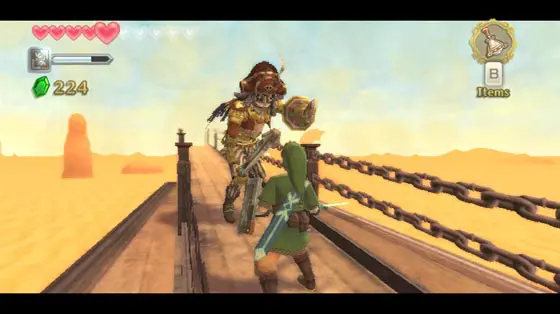
Because of these new tools, weapons and devices, the developers are able to keep the series fresh.
The elements that the game borrows from previous installments include the trials in Silent Realm, which reflect back on the things that Link had to do in the Temple of the Ocean King in the DS game, Phantom Hourglass. There is also a finishing sword move that hearkens back to Wind Waker. The game’s villain is a effeminate emo kid named Ghirahim, which is very close to the name of the wizard Aghanim (and they both have the same motives) from the SNES classic, Link to the Past. There is even a plot point in Skyward Sword where Zelda goes into a deep sleep, ala The Adventure of Link. As I said, this game takes the best of what has come before and uses those elements to paint a true masterpiece.
Skyward Sword is the first Zelda game to fully utilize motion control, and with the Wii Motion Plus controller, Nintendo is able to simulate 1:1 action with the sword. What follows is some of the best sword fights in gaming history.
In Twilight Princess, a simple jerk of the remote would cause your sword to swipe or jab. In Skyward Sword, you have to plan your parries, swipes, and thrusts around the enemies defenses. Even a simple fight with a Bokoblin turns into a major duel, and let me tell you, it is incredible.
The new move for this game, the Skyward Strike, is a powerful sword technique that is initiated by pointing the sword toward the sky to charge it then swinging it down on your enemy. With 1:1 motion, you, as the player, literally point your remote toward the sky. For the record, I never once felt “nerdy” doing this.
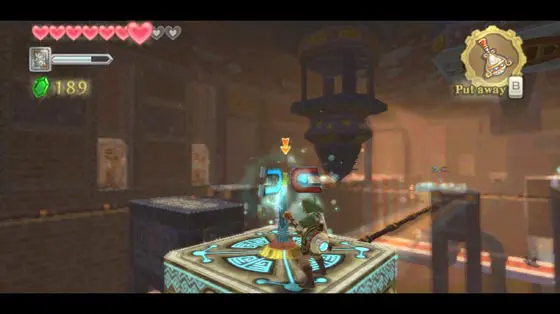
And before I get any further, the final battle is ridiculously epic. In so much that I leapt up from my couch in excitement of winning the final fight. I hadn’t really cared about Wii Motion Plus before, but now I want every game that involves a sword to utilize it. It is incredible.
The Wii controller was adequate for Twilight Princess, but with Skyward Sword, it takes on a new level of awesomeness. Not only does it shine in 1:1 combat motion, but using the remote’s internal gyroscopes to guide the Beetle is intuitive. Using the point-and-shoot of the remote for the hookshot, bow, and slingshot is spot on (literally).
Graphically, Skyward Sword is a step back from the dark, pseudo-realism of Twilight Princess, but not as cartoony as the cel-shaded Wind Waker. And it works masterfully. The emotion that the Nintendo artists can convey with simple water-colored inspired character designs is brilliant.
The color palette is vibrant and near tropical on Skyloft, and then adjusts as you visit each of the game’s locations without losing any vibrancy.
Speaking of, there are only three locations in the game. Skyloft works as a hub of sorts, and Link can travel to the Faron forest, Eldin Volcano, and Lanaryu Desert. Each location has three or four sub-locations (as an example, Faron woods has the woods itself, a temple, and Lake Floria). Seeing as the “rule of three” has been a deep part of the Zelda Mythos for years (Zelda, Link, and Ganon are all intrinsically entwined), it makes perfect sense to constrain Skyward Sword to the rule.
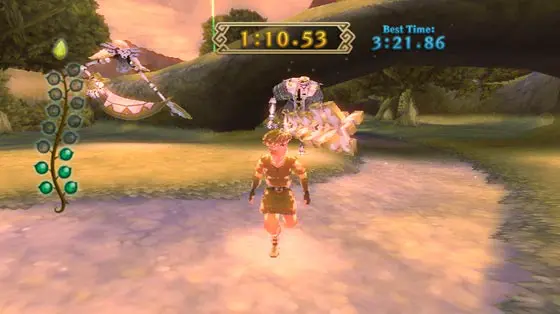
There are three trials to overcome, three goddess flames to infuse into your sword (again, you are essentially creating the Master Sword in this game), three songs to learn – and for the fourth later on, you have to find three parts to complete it. And you basically go to each location three times for various reasons. Threes are everywhere in Skyward Sword and it works.
Another thing that the Zelda series is known for is music. From the whistle in the original Legend of Zelda adventure, music and musical instruments have played a huge part in each game. Ocarina had, well, the ocarina, Wind Waker had a conductor’s wand, and the GameBoy classic, Link’s Awakening, featured a quest to find eight different musical instruments.
In Skyward Sword, the instrument of choice is a harp. You play the harp by simply swiping the remote control while holding down the A button. The harp is used to find goddess walls and hint statues, as well as to open doors to further your quest. I also found myself playing the harp at different parts of the game simply because I could. It was a neat experience.
The in-game music, as usual for the series, is sweeping and epic. As you go along the adventure collecting songs on your harp, the last song you learn is the Song of the Hero, which resembles the original Zelda Theme. This is the only time that this piece of music is played in Skyward Sword.

Keeping with the Golden Zelda Rule laid forth by series creator Shigero Miyamoto, Link is primarily silent in Skyward Sword. Mr. Miyamoto has said that keeping Link silent allows the player to imagine his own voice as Links. Instead of words, Link conveys emotion with a series of grunts and noises, and incredibly, it still works perfectly.
If I had one gripe with Skyward Sword, is that the final “third” of the Holy Trinity of the Zelda Mythos – Ganon – is not a part of the game. His spirit, as laid out and explained in Ocarina, is present as the “king of evil,” but he is not named or referenced as Ganon. As a lifelong Zelda fan, I did not agree with this decision by producer Eiji Aonuma, and I think they could have still kept the game unique by using Ganon in the very end.
With tons of side quests (most actually fitting into the grand story overall), and bug catching and treasure hunting components, Skyward Sword can easily last well past 50 hours, and has been said to go up to 100 hours or more to completely finish. And after you complete the game, you are given the option to enter the Hero’s Quest, which is a much harder version of the same game.
Sometimes, words like “best ever,” and “Masterpiece,” get thrown around too frequently in game reviews to have any affect whatsoever to the reader. And sometimes those words are warranted.

The Legend of Zelda: Skyward Sword has done something that most people thought impossible: It has topped Ocarina of Time in the pantheon of great Zelda games. It is a masterpiece. The incredible control system, coupled with a new, emotionally charged “origin” story, has come together to create the best Zelda experience to date. I would even go so far to call Skyward Sword the best Wii game ever, and it easily sits in the top five best Nintendo games of all time.
Twenty-four years ago, I began a grand journey that has never truly ended. The story has been epic and has spanned not only time, but different games and game platforms as well. The classic story of Link and Zelda means a lot to people all over the world, myself included. Their story is one of my favorite games of all time, and it truly is a Legend.
Shop for The Legend of Zelda: Skyward Sword for Nintendo Wii at a discounted price from Amazon.com.
